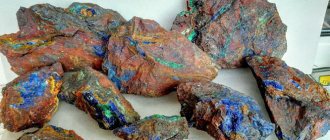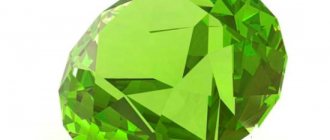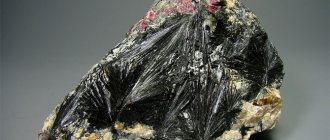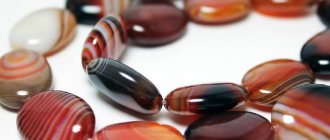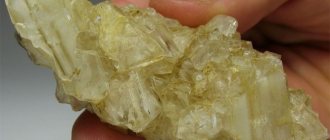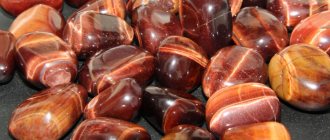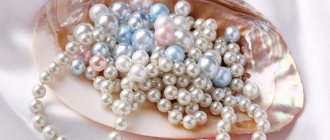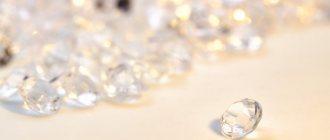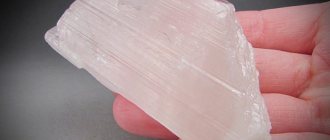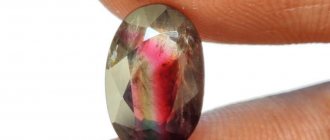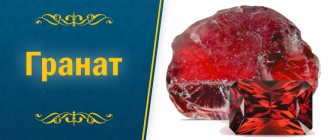Steatite (soapstone, soapstone, waxstone, icestone, wen, tulikivi) is one of the most unusual gemstones.
Soapstone is actually dense talc, which is why this gemstone is sometimes called “soapstone.”
But the main feature of steatite is different - this stone is so smooth to the touch that it feels like it is greasy. For this property, steatite was called “wen”, “wax stone”, “soap stone” and “ice stone”.
However, it is a very soft stone (you can practically draw with it like chalk), therefore, although this precious stone has been known to mankind for a long time, it was used only for carving figurines and various utensils.
The color of soapstone is usually white, yellowish, gray, brown with a greenish tint. Less common are red or cherry colored soapstones.
Now, however, there is technology that makes it a very strong stone - this happens when the stone is heated to 1000 degrees. Then the soapstone becomes so hard that it can be used to cut glass.
Medicinal properties
Residents of Finland consider soapstone their national stone and call it “tulikivi” - “hot stone”. The Finns gave this name to steatite not by chance. The mineral has high heat resistance. It is an ideal fireproof material that heats up quickly and cools down slowly. A piece of soapstone, immersed in hot water for just 5 minutes, cools down within an hour! Thanks to this property, soapstone is a natural heating pad. In Finnish and Karelian medicine, steatite is used to treat radiculitis, sciatica, osteochondrosis, traumatic joint injuries and other similar diseases, for the treatment of which uniform and prolonged heating is useful. Mineral heating pads are made from steatite, convenient for use at home. It has been established that steatite also has strong energetics with a vibration frequency close to the vibrations of the brain. This property of steatite underlies the work of biostimulants that are made from this unique mineral.
Jewelry, amulets and talismans made of soapstone
The structure of the stone makes it possible to use it in creating a variety of products:
- Jewelry;
- animal figurines;
- miniatures;
- interior decorative elements.
Jewelers fell in love with soapstone for its unusual color, silky and matte shine. It is often framed in silver. Soapstone is commonly used to make beads, bracelets and brooches.
Soapstone is considered a talisman for all those immersed in the world of mediums, magic and research. The amulet is an ordinary figurine of an animal or a ball. The talisman helps the owner get rid of negative emotions, reveal the mysteries of the Universe and clarify thoughts. The amulet protects against evil spirits.
Areas of application
Thanks to its versatile properties, soapstone is widely in demand not only in crafts, but also in the industrial industry.
Construction
Crushed and ground soapstone of technical quality is a raw material for refractories, cement compositions, and electrical insulators.
Soapstone is used to line the walls of residential buildings and swimming pools, and to install “warm floors”. Soapstone is also an excellent soundproofing material.
Arrangement of baths and saunas
Soapstone crushed for baths
Due to its high heat capacity and thermal conductivity, the mineral is used in the construction of baths, steam rooms and saunas. Stone blocks used in baths look aesthetically pleasing, reliable and environmentally friendly.
Drink stones
Soapstone quickly not only accumulates heat, but also cools. In status circles, it is used instead of ice cubes to quickly cool a drink without diluting it with water. To do this, the treated soapstone cubes are placed in the freezer for several hours, after which they are used for their intended purpose. Used pebbles are washed under running water and dried.
Decor
Protective amulet with the Algiz rune, soapstone
Soapstone is plastic and easy to process, so it makes beautiful decorative elements. Vases, figurines, animal figurines, boxes, and souvenirs are made from the mineral. Due to its high thermal conductivity, dishes made of soapstone are in demand. Food cooked in a pot or frying pan made from this stone remains warm for a long time.
Decorations
The stone is not popular among jewelers due to its excessive softness. However, it makes unusual jewelry, set in cupronickel or silver - beads, pendants, pendants.
What is it: soapstone?
Soap appeared relatively recently in human history. Much later than fat. Although... technically, soap is a salt of a fatty acid, that is, fat treated with alkali. However, this information is unlikely to help understand what it is: soapstone.
After it has become possible in our time to buy soap from a piece of stainless steel, it becomes quite acceptable to assume that, in the absence of stainless steel, our ancestors washed themselves with stones. But that's not true.
Soapstones, piled. Saunamart Photos
In essence, we are simply talking about , which is slippery to the touch . Those who have dealt with baby powder or sports talcum powder will immediately understand what we are talking about. So, if the French did not change their opinion that it resembles fat, then the English-speaking world apparently winced and decided that the association with soap was more decent. Therefore, if you search for soapstone in English, it is better to type soapstone into the search.
Again, the name “soapstone” does not prevent it from being used in construction, for example.
What is potting stone?
The name " pot stone " suggests that it was used to make pots. But everyone knows that ceramics are made not from stone, but from clay. Right. However, if it is made from clay, then it must be fired, otherwise it will not become resistant to water.
In addition, you know very well that you cannot put ceramic dishes on an open fire - they will burst.
Crushed soapstone. Photo by Maxidom
But if the same thing is made from stone , then there is no need to burn it, and you can put it on fire. Only the stone must be quite convenient to process, then the utensils that are in demand in all times, except for very primitive ones, can be made a lot and quickly.
And such a stone was found in nature. This is soapstone, which cookware makers nicknamed “pot stone.” The choice in its favor was made because of the softness of the stone, which depends on the amount of talc in its composition. And, in turn, the proportion of talc among soapstone minerals differs for each specific deposit and even section of the vein, but in general varies in the range from 30 to 80 percent . And any variety can be sawed even with an ordinary knife.
They made not only pots from it, but also all other utensils that could be useful in the household - bowls, cups, dishes, glasses, glasses, frying pans and other containers.
Use of soapstone
Soapstone has been used for a long time as a potting stone. Vessels hollowed out from steatite solids are not afraid of heating in an oven and, importantly, are completely inert in aggressive environments of kitchen chemicals.
The inertia of steatite is also useful in the bar business. For customers who do not like to drink diluted whiskey, but prefer to drink the drink chilled, frozen pieces of the same soapstone are placed in the glass. According to tasters, the stone does not in any way affect the taste and strength of alcohol.
The thermal conductivity and heat capacity of steatite have also found application in balneotherapy. Massage with stones heated to a comfortable temperature is performed with soapstone. The stone, rolled into large pebbles, easily glides over the skin, transferring beneficial warmth to the underlying tissues.
There are rich traditions of making figurines and interior decorations from soapstone. The stone can easily be processed by any mechanical process, which allows you to cut elegant figurines and abstract figures from it. Similar soapstone products are found even in the tombs of Ancient Egypt!
True, in different deposits the properties of steatite are different. The deposits of northern Europe provide a stone that is perfectly suited for technical needs, but is not in great demand among sculptors. The known fragility of European steatite determines the mostly industrial use of the rock. The extracted steatite is crushed, ground and added to ceramic mixtures for refractory, electrical insulation and construction purposes.
Soapstones from the Southeast and Africa are more suitable for stone cutting.
What is it: soapstone stone
Since it is already clear that all the names come down to one thing, it’s time to talk about what soapstone is from the point of view of physics and, of course, from the point of view of practice - where and how it is used these days.
Basic physical characteristics of rocks: color, structure, hardness, density, specific gravity.
Color and structure, green
The color of soapstone depends on the presence of impurities. The fact that in advertising you only see a gray stone with beautiful white veins is only one of the options. In our country you can also find green and brown varieties. In Brazil and India, more exotic colors are found, for example, cherry.
By the way, green soapstone may have this color for two reasons: either it contains a lot of the mineral chlorite, which itself has a green color, or it is serpentinite, which the seller is trying to sell instead of soapstone - this may not be malicious intent, because the talcochlorite occurs in a serpentinization zone, that is, two rocks are very closely adjacent and can be mined simultaneously, including by accident.
Bath stone embanked with soapstone. Photo Horizon
As for the structure, most often it is schistose. This means that there is layering in the rock, which affects the physical properties of the stone depending on the direction - along or across the layer.
Hardness, density, specific gravity
The hardness of soapstone directly depends on how much talc it contains. The intrinsic hardness of talc is 1 on the Mohs scale. Other rock components can have a hardness ranging from 3 to 5. Therefore, the hardness of soapstone chlorite ranges from about 1 to 4.
Here it should be said that soapstone chlorite has a brother - soapstone magnesite. We wrote about it here. So, the hardness of soapstone can be 5 if the proportion of magnesium carbonate (magnesite) in it is high enough.
Soapstone chlorite differs from soapstone magnesite in that the concentration of which mineral in it - chlorite or magnesite - will be 30% or higher. Accordingly, the share of the second is significantly reduced to several percent, because there is also a lot of talc in both breeds.
The specific gravity of soapstone is measured as the ratio of the density of the stone to the density of the liquid it displaces. For soapstone chlorite this value is 2.58-2.83.
The density of soapstone is the ratio of mass to the volume it occupies. Reference value is from 2.6 to 3.3 g/cm³.
Note that all physical quantities for rocks are given either as an average value or for specific samples (deviations in any direction are possible here).
Fire stone
The stone we are describing has a property that we have not yet mentioned - its fire resistance. In principle, it is rare that any stone will melt from fire, but some will crack from an open flame. However, every stone has a temperature limit that it can withstand while remaining solid. Stones also differ in the speed at which they heat up and cool down.
Sawn soapstone. Saunamart Photos
The melting point of soapstone is 1630-1640 degrees.
The fire stone soapstone fell in love with humanity because it was reluctant to heat up from fire, but, having already warmed up, it then retained the heat for a long time and gave it away for a long time. This is an excellent property for furnaces, but over time the need for refractories increased in industry, and soapstone became the basis for magnesite refractories.
Fire-resistant products are cut from it, which are then fired at a temperature of 1000-1300 degrees. Already at 900 degrees, bound water disappears and the following reaction occurs:
Mg3Si4O10(OH)2= 3MgSiO3 + SiO2+ Н2O
Silica turns into cristobalite, magnesium silicate into enstatite.
The main purpose of refractories in industry is the lining of furnaces.
Place of Birth
Extraction of soapstone chlorite Deposits
of soapstone chlorite are found on almost all continents.
It is mined in industrial quantities in Finland, the USA, Thailand, China, India and Brazil.
Russia ranks second in terms of production volumes among all suppliers of the mineral. The largest deposit is located in Karelia - a mountain ridge runs from the borders of Finland to Medvezhyegorsk. Soapstone chlorite is also mined in the Urals in the Shabrovskoye deposit.
Stone compatibility according to horoscope
The influence of soapstone on zodiac signs:
- It suits the zodiac signs Pisces, Virgo, Gemini and Libra. This will help them achieve harmony within themselves and become more confident. The maximum properties of the stone are manifested if you make talismans with your own hands and put your own soul into them.
- Scorpio, Capricorn, Aquarius and Cancer should wear such jewelry with caution. This rock makes these symbols more suspicious and gullible.
- It is forbidden to use stomatitis for Sagittarius, Taurus, Aries and Leo. With the help of this mineral, the negative aspects of these symbols (aggression, irritability, selfishness and self-confidence) only increase.
Soapstone (soapstone) and a sink made from it ("What is it made of")
